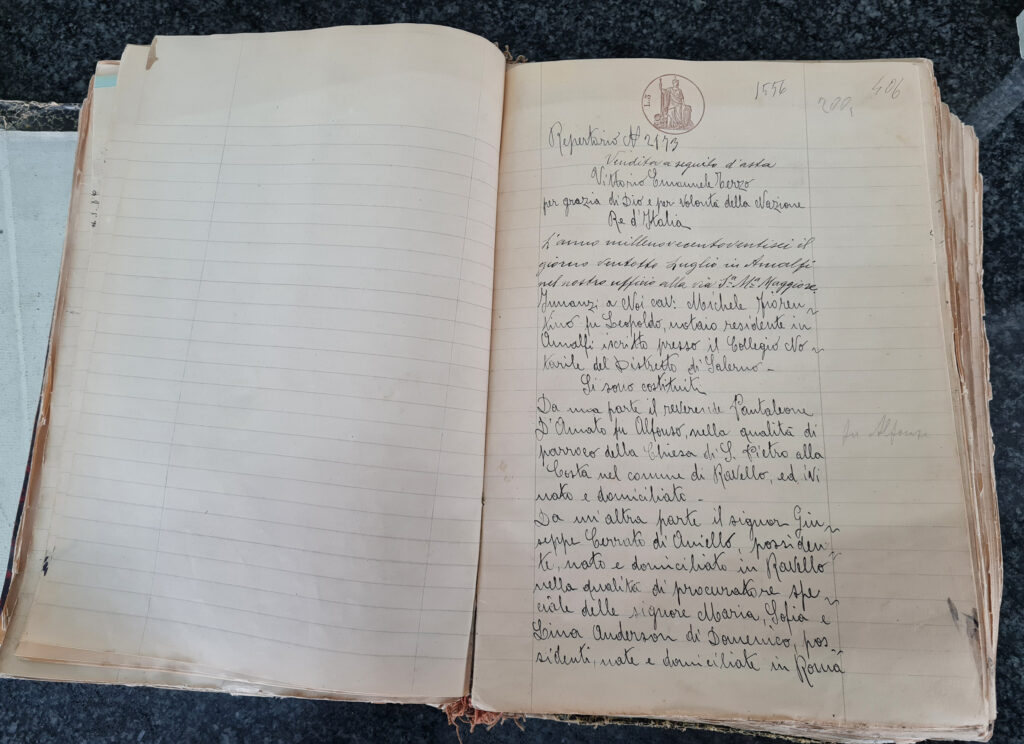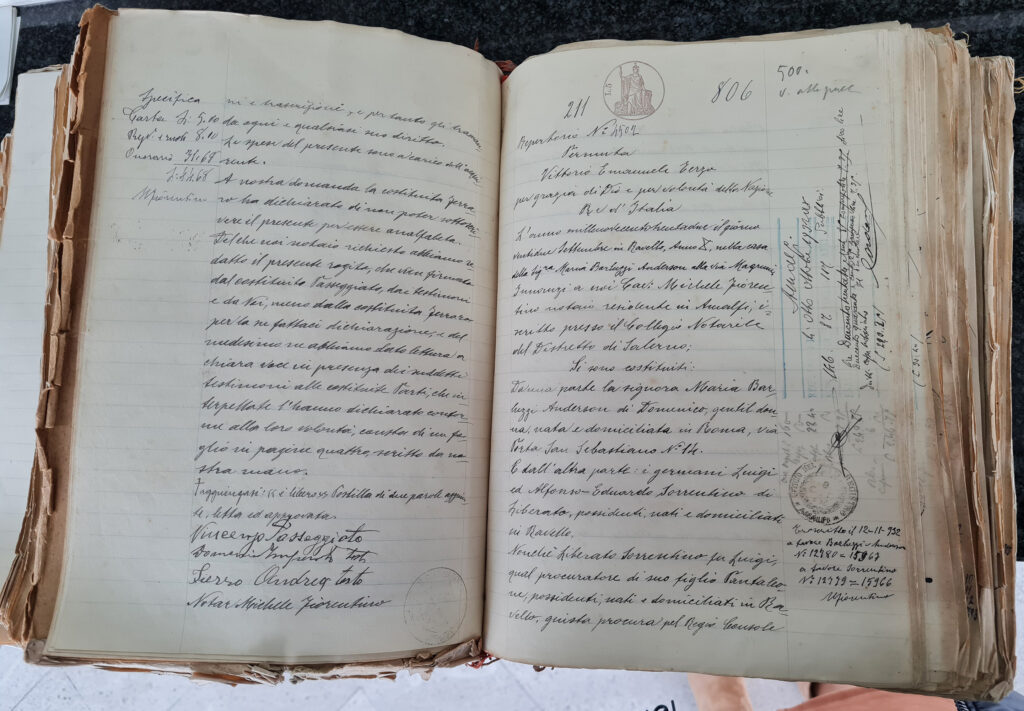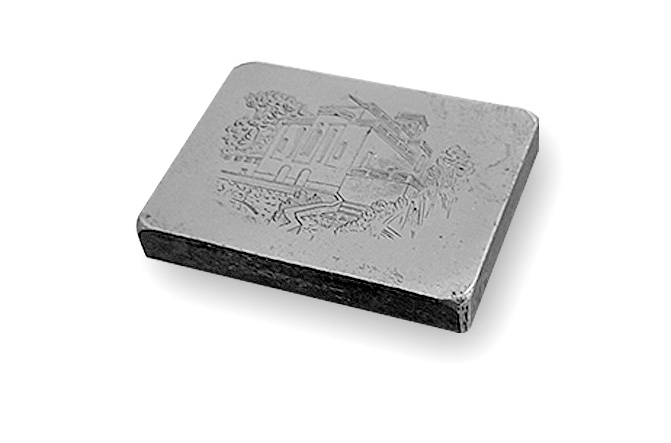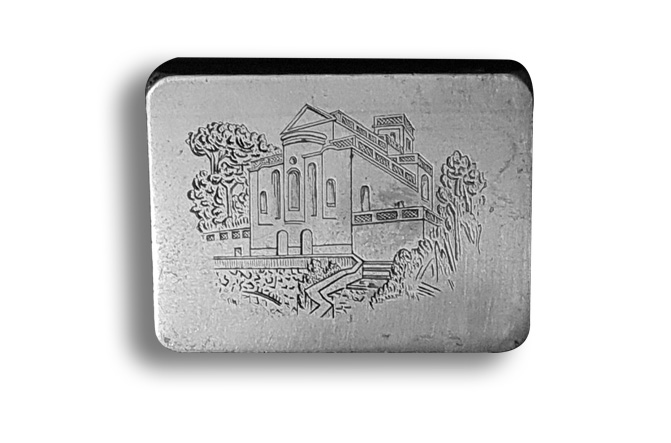The origins
Sant’Andrea del Pendolo: historical events from the church to Villa Barluzzi
The church of St.Andrew was situated in the eastern sector of the city of Ravello, along the slopes of the hill descending towards Minori, in the Pendolo district, whose toponym indicated a steep terrain, sloping down from a mountain and generally characterized by terrace cultivations.
In 1145 Giovanni Carissi was its rector, he was involved in the affair relating to a land located near the church, purchased by Ursone de lu Pendulo, for which an appeal was brought to King Roger II in Palermo.
Near the church, as for the nearby St.Matthew’s church, a cluster of houses must have formed, consisting of different spaces, some in common such as courtyards, cisterns and ovens, called convicinio, while, next to it, in 1535, there was a street level uncovered house with a small garden known by the name: “the courtyard of St.Andrew”.
In 1549, there were three altars in the church, located in correspondence with the apses, of which the central one kept the painting depicting the Virgin in the middle with Saints Andrew and Nicholas, while the two lateral ones had no sacred images. In the same years, the existence of a crypt seems also to be attested, it had external access, through a door separated from the church.
A chapel dedicated to Holy Mary had been built in the church, towards the end of the fifteenth century. The church was also the beneficiary of a donation to which Mendola Flaibolo had bound herself by an oath, but from this vow she was released by Bishop Cosma Setaro in 1497.
As far as liturgical practice is concerned, the Cathedral Chapter of Ravello was required to sing vespers and mass there, on the eves and feast days dedicated to St.Andrew and St.Nicholas, the latter following the annexation of the benefice of San Nicola in Bivara. On these occasions, a pound of wax was prepared for the church and bread to be distributed to the poor.
On 27 October 1577, during the pastoral visit of the bishop of Ravello Paolo Fusco, this place of worship was entrusted to Don Andrea Fusco, who succeeded the beneficiary Paolo Furno, with the responsibility of celebrating the Sunday mass.
The large painting depicting the Virgin and Saints Andrew and Nicholas was also attested on the high altar, as well as a new tinsel cloth with the image of Saint Andrew, three tablecloths, two new wooden candlesticks, a complete vestment for the celebration of masses, a new missal. On that occasion the silver chalice with the paten were not found because they had been taken to Naples for restoration. In this sacred place there were also the font for blessed water, the tintinnabulum, in which the bell for liturgical use was placed, and a pulpit supported by small columns. The building was also provided with two bells, while two other altars were devoid of any vestments.
During the Visit, since it was not possible to find out about the ancient financial burdens of masses and on which incomes they should weigh, the beneficiary was ordered to celebrate an annual mass for the souls of the faithful departed and an anniversary deriving from a census of four carlinuses transferred from the church of Holy Mary ad Lao, paid by Colapietro Coppola, known as Varricchio, and his brothers.
The patrimony of this place of worship consisted of income from censuses and fees levied on real estate properties and from the assets of which he was the direct owner, starting from a chestnut grove with oaks, situated in the locality of Ravello known by the name “At Iacono’s cave”, from which he received an annual fee of 10 carlinuses and two bushels of chestnuts.
Other chestnut groves pertaining to Sant’Andrea del Pendolo were located in the “Acqua Sabucana ” area of Ravello and in the localities of Figlino and Cesarano of Tramonti, the latter belonging to the church since 1275.
At the end of the canonical visit, the prelate Paolo Fusco ordered the chaplain not to interrupt the celebration of Masses and anniversaries and, under pain of excommunication, to provide for the installation of a confessional for the celebration of the sacrament of penance and the purchase of a gilded wooden crucifix for the ornament and liturgical needs of the church.
At the beginning of the 17th century, the parish priest of Sant’Andrea del Pendolo was Giovanni Andrea de Fusco, who in 1602 was ordered to repair the roof of the church, so that it would not rain inside, but two years later no intervention was carried out. For this reason, under condemnation of doubling the previously established penalty, the parish priest was ordered not to celebrate on the main altar with the uncomfortable portable altar used up to that moment, because it was barely possible to place the chalice with the wafer there. The tin cruets had to be replaced by glass ones and it was necessary to intervene on the walls invaded by roots. For the altar located near the main one, demolition or restoration were prescribed together with the endowment of the liturgical furnishings.
In 1609, the parish church of Sant’Andrea del Pendolo was joined to that of Santa Maria de Lago, which was located under the sanctuary of Saints Cosma and Damiano, due to the proximity of the two communities and the small number of parishioners. With the new union, St.Andrew’s church appropriated the rights and income, with the burden of presenting a pound of white wax worked on August 15 of each year, at the Episcopal Mensa of Ravello as a sign of obedience.
In the same years, moreover, due to its proximity to the parish church of San Matteo del Pendolo, of which the parish priest of St.Andrew was vicar, the Mass was celebrated alternately every week in one of the two churches, until the union was confirmed in 1617, when Don Pompeo Manduca became curate.
In the same year, the church needed urgent maintenance work, because of the bad conditions of the vault, for which the support of the parishioners was requested. Likewise, the bell tower had to be repaired so that the bells could be placed there, but in 1621 the interventions had not been completed yet.
In 1636, the year of the canonical visit made by bishop Onofrio del Verme, the church had only one altar decorated according to the rules, but it was necessary to close an existing window on the wall behind the altar and all the other openings in this sacred place.
The building once again required urgent maintenance work, for which it was ordered that the roof, walls and doors be repaired quickly, establishing, in the event of default, the transfer of the celebrations to the nearby church of the Santissima Annunziata. The bell tower, shaped like a tower, had two bells, there was no sacristy and the burden of the celebrations was shared alternately with the church of San Matteo del Pendolo.
The small income and the low number of parishioners did not allow for the repair of the church, to the point that in 1643 the new treasurer, Valerio Mosca, was ordered to institute a tax and to use the proceeds for the repair and for the construction of a new confessional.
Furthermore, it was prescribed to build a new altar within ten days and in the middle of the place of worship there was the mound intended for the burial of the parishioners.
Among the objects of liturgical use recorded in 1643 there were an ancient chalice with paten and another chalice belonging to the parish church of St.Matthew, two red chasubles, four gilded candelabra, four vases with silk flowers for decorating the altar and two altar cards.
It is possible that the better stability conditions of the building, despite the ancestral repairs to be carried out, allowed the church of Sant’Andrea, until the end of the 17th century, to also perform the parochial functions provided in the nearby church of San Matteo.
In 1694, in addition to the well-preserved main one, an altar had also been built in the church surmounted by the picture of Saints Cosma and Damiano, testifying to the jurisdiction that the parish of St.Andrew also had over the ancient church of the Physician-Saints, today a diocesan sanctuary.
At the beginning of the eighteenth century, it was necessary to plaster and whitewash the perimeter wall of the church, repair the door to close it better, close two windows next to the altar, which on windy days caused disturbance to the celebration. It was also necessary to build a wall to prevent neighbours from accessing the roof of the church.
In 1710, Sant’Andrea del Pendolo may have also received the fresco with the image of St.Matthew and the bones of the dead, transferred from the church of the same name, following its desecration caused by the danger of collapse. After the restoration carried out by the faithful, which took place between 1718 and 1719, this place of worship also assumed the dedication to Santa Maria delle Grazie.
Then, due to the uneven floor and the humidity which had caused extensive damage to the walls, in 1718 Bishop Nicola Guerriero ordered that the parish care of St.Andrew be transferred to the restored church of St.Matthew until the maintenance works were finished.
Failure to restore it condemned the building to progressive abandonment, to the point that in 1726 the altar was forbidden to the worship of the faithful, the demolition of the door was ordered and a cross was placed in memory. The threat of similar measures generated a new restoration, with the consequent postponement of the previously issued orders.
With the definitive transfer of the celebrations to St.Matthew or St.Mary of the Graces, confirmed in the 1730s, the church of Sant’Andrea del Pendolo was no longer used for parish life, but still retained its parish title for a few decades.
At the beginning of the 19th century, it was in ruins and the remains of it were represented by the perimeter walls, the covered atrium and the bell tower, while the three naves of the church were punctuated by pillars belonging to the original building.
As far as parish life was concerned, at the beginning of the 19th century, the number of faithful amounted to around 170 souls and the annual income was around 52 ducats. Of these, 32 were landowners, 1 was priest, 37 were peasants “in charge of the work of the countryside”, 4 were fishermen and 4 were artists “with their servants”.
However, these were the last moments of life of the parish community of S. Andrea del Pendolo, because in 1812 the entire ecclesiastical structure of the town was redesigned.
As early as 1810, in fact, the Minister of Worship, Francesco Ricciardi, had ordered the plan to reduce the parishes of the Diocese of Ravello, which had been vacant since 1804 due to the transfer of Bishop Silvestro Miccù to the seat of Amalfi.
The following 25 October, the Vicar Capitular of Ravello Francesco Mansi reached the definitive solution, drawing up a plan that would organize the 1300 inhabitants of the town in four parishes. It was a number dictated by necessity, because of the “situation of the mountainous place, of the dispersed houses, and for more miles distant from each other and of the disastrous roads”.
Thus the parish of the Cathedral with the annexes of San Giovanni del Toro and a portion of the parishioners of S. Andrea del Pendolo are confirmed, that is «all those who live in the vicinity of the ruined church of S. Andrea del Pendolo and of the Madonna delle Grazie until to the place called Portadonica ».
The Parish of San Pietro alla Costa was united with that of S. Giovanni alla Costa and would have jurisdiction over the “rest of the children of S. Andrea del Pendolo, that is, all those who live in the district of San Cosimo, from below Portadonica to Castiglione “.
The definitive resolution of the Minister of Worship Francesco Ricciardi, dated 11 July 1812, thus determined the suppression of the parishes of S. Martino and S. Andrea del Pendolo, for which, after a few years, the Municipality of Ravello proposed the use as cemeteries, pending the construction of the public cemetery.
The area on which the ruins of the ancient church of Sant’Andrea was situated, measuring 110 square meters, and two other neighbouring rural buildings, owned by the parish prebend of San Pietro alla Costa, were purchased by a notarial deed dated 28 July 1926 and signed by the notary Michele Fiorentino of Amalfi, by Maria Anderson, wife of the papal engineer and architect Giulio Barluzzi (1878-1953).
Following a subsequent exchange with Luigi Sorrentino, stipulated on 22 September 1932 by the Florentine notary himself, a pertinent vineyard of 180 square meters and an orchard of 27 square meters were added to the real estate assets.
The ruins of the ancient place of worship were used as a residential structure and the new Barluzzi residence had the honour of hosting, from 24 February to 5 March 1950, the President of the Republic Luigi Einaudi, during his strictly private stay in Ravello.s
Proof of Purchase of the ancient Church of Sant’Andrea del Pendolo
Notaio Michele Fiorentino di Amalfi
Data dell’atto: 28 luglio 1926, registrato il 18 agosto 1926, n. 73
Permuta vigneto e frutteto adiacenti all’edificio
Notaio Michele Fiorentino di Amalfi
Data dell’Atto: 22 settembre 1932, registrato l’8 ottobre 1932, n. 146.
Historical reconstruction handled by Dr. Salvatore Amato of the State Archive of Salerno.


Exclusive original mold
of Villa Barluzzi


